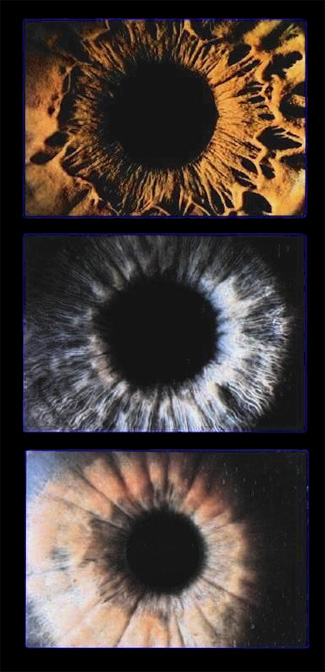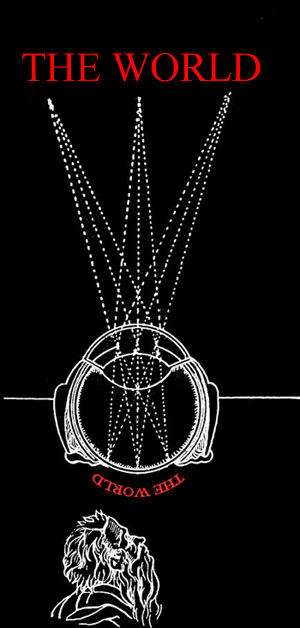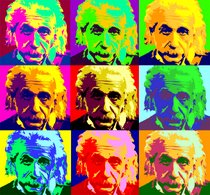“Was that the pupil we just went through? There was nothing there apart from more watery stuff.”
That’s right the pupil is just a hole in the iris, the coloured part of the eye. “Not very exciting things then, these pupils.”
“Not very exciting things then, these pupils.”
Their main job is the important but unexciting task of controlling how much light gets into the eye. When it’s bright they can constrict down with tiny little muscles around the edge of the pupil to let less light in. In the dark they get big to let in as much light as possible. But pupils can be very interesting things. They are emotional, responsive and sensitive. Humans look through them and sometimes stare lovingly into them. They can also give away what you are thinking.
“That’s daft. You can’t really tell what someone is thinking from their eyes.”
Well not exactly but you can get some good clues. Your pupils get bigger when you are stressed. Some new lie detectors even measure pupil size along with other things like voice pitch, sweating and heart rate. Large pupils can also be a sign that you find whoever you are looking at very attractive. Years ago young ladies would put an extract of the poisonous plant Deadly Nightshade in their eyes to make their pupils bigger and themselves more attractive.
"What has being attractive or attracted to someone else got to do with pupils?"
Do you want the whole birds and bees thing explained or just the pupil size thing.
"The pupil size thing will do fine thanks."
That’s a relief. When you find someone attractive, or when you are happy and relaxed, your pupils dilate. There are two systems in the body that control all this and they are wired into the emotional parts of the brain; the sympathetic and para-sympathetic nervous system. The sympathetic is the pupil dilating system - the positive, let’s get going system. The parasympathetic is the let’s sit down, do nothing and digest lunch system. The sympathetic system also gets going in other ‘lets get going’ situations, such as an ‘I'm terrified lets get out of here situation.’ That’s the system that gives you away in a lie detector.
"That doesn't explain it at all. Taking deadly nightshade to make your pupils bigger will make it look as though you are either afraid of or attracted to the other person. Why should that make you attractive?"
I'll admit courtship is complicated, but it's a little bit of subconscious flattery. Someone else finding you attractive, is very attractive.
"I think relativity is easier to understand that this human relation stuff.”
I agree completely.
“One thing I don’t get. If pupils are black, shouldn’t they be absorbing light rather than letting light through?
It’s black because not much light comes out of the eye. Most the light that gets in is absorbed at the back of the eye. Of course if you shine enough light in some escapes. That’s what happens in a flash photo when your pupils are red.
"But if the pupil's get smaller in bright light won't that stop most of the light from the flash from getting in the eye."
Yes, but human brains are slower than cameras. By the time the brain has worked out that the flash has happened the photo has been taken. A fraction of a second later the pupils constrict. That’s why some camera’s flash blinks for a few time before taking the picture. This gives humans rather slow brains time to make the pupils smaller and so stops red-eyed photographs. For humans the red eye look from flash photos is a nuisance, but some animals have eyes that use the ‘red eye’ effect to see better when it’s dark. Cat’s eyes, the ones with four legs rather than the ones in the road, have a special reflective layer called the tapetum in the back of the eyes so much more of the light that gets into the eye is reflected back.
“How does that help?”
This helps them see in dim light because it gives them two bites at the cherry. The light that isn't absorbed or seen on the way into the eye is reflected back and some of it will be seen on its way out of the eye. So the eye has a second chance to see the photons it missed first time around. Scoring on the rebound so to speak.
Just behind the pupil is the lens. This is the part of the eye that allows the eye to focus on fine detail at different distances. It is just like a magnifying lens but rather than being made of glass is a springy glob of transparent protein. This glob is very elastic and constantly wants to be ball shaped but is pulled into the proper lens shape by a ring of fine fibres called the Zonules of Zinn.
"Wasn't he the mad Spanish swordsman who slashed the letter Z in everything and everyone?"
No that was Zoro. Johann Gottfried Zinn was the man who found these zonules in the first place over 200 years ago. These zonules can change the lens’ shape by being attached to small ring of muscle in the eye, the ciliary muscle. Every time you look from a far away object, like a star, to something up close, like this book, this muscle contracts and in a fraction of a second changes the focusing power of your eye so the pages of the book are clear and in focus. Unfortunately as your eyes get older the lens becomes stiffer and stiffer and so cannot round up so much to allow you to read close up. So you hold books further and further away. Then one day you find your arms aren't long enough.
“What happens then?”
You have to admit you are getting old and get reading glasses or start carrying heavy weights in the hope that your arms get a little longer.
“Hmm, how about we get back to this lens thing.”
Well, going back a few thousand years to the start of our journey the understanding of how eyes worked was a little primitive. Back then, people thought it was the lens that detected light and made people see.
“How can something transparent be the place where light is detected? The light should go straight through it.”
Exactly. Also what do all the bits of the eye behind the lens do if seeing is done by the lens near the front of the eye? The man who sorted all this out was Johannes Kepler.
"Wasn't he the man that..."
Worked out the orbits of the planets and the three laws of planetary motion? Yes, the very same man. In his spare time he invented the modern science of optics and worked out the optics of the eye in 1604. He worked out that the cornea and the lens of the eye work like a normal glass lens and the whole eye acts like a small camera.
“They had cameras back then?”
There was a type of primitive camera back called the camera obscura. The only problem was that it wasn’t until 1888 that John Corbett, an Englishman living in America invented film.
“What use is a camera without film?”
Well camera obscura means ‘dark room’ in Latin and that explains what they did without film. A camera obscura was a dark room with one small peep-hole into the outside world with lens in it, just like the lens in a magnifying glass. The picture from the camera lens was projected on a screen or a far wall and it had to be dark to be able to see this faint image. People paid just to see this strange upside down image because at the time this looked almost like magic to most people. Some artists even used this to help them paint. To get all the sizes and shapes right they just had to trace around the outline of the upside down image and then turn the picture right way up. At the time people really didn’t believe Kepler. If he was right that meant that the image of the world inside the eye was upside down just like the image in a camera obscura. That seemed just as unlikely as feeling rays coming out of the eye. But Kepler was right. This very sentence is being focused upside down on the inside of your eye as you read. Kepler was proved right a few years later by the French philosopher Renee Descartes, who is most famous for his statement, ‘I think therefore I am’. He published a book on optics that showed the picture of an experiment first done by Christophe Scheiner In this macabre experiment, the outer layers are peeled off the back of an eye taken from a dead ox. This leaves the thin, almost transparent innermost lining at the back of the eye. Sitting in a darkened room with this eye pointing out a small hole into the world outside, Scheiner saw a faint upside down image of the world - just like a tiny camera obscura. It’s a bit eerie that the last thing that had seen through that eye was the ox itself.
At the time people really didn’t believe Kepler. If he was right that meant that the image of the world inside the eye was upside down just like the image in a camera obscura. That seemed just as unlikely as feeling rays coming out of the eye. But Kepler was right. This very sentence is being focused upside down on the inside of your eye as you read. Kepler was proved right a few years later by the French philosopher Renee Descartes, who is most famous for his statement, ‘I think therefore I am’. He published a book on optics that showed the picture of an experiment first done by Christophe Scheiner In this macabre experiment, the outer layers are peeled off the back of an eye taken from a dead ox. This leaves the thin, almost transparent innermost lining at the back of the eye. Sitting in a darkened room with this eye pointing out a small hole into the world outside, Scheiner saw a faint upside down image of the world - just like a tiny camera obscura. It’s a bit eerie that the last thing that had seen through that eye was the ox itself.
"So why doesn't the world look upside down?"
It is almost impossible to imagine how the brain does it, but as babies start to seeing things and learning about the world through the images captured by the eyes, the sense of ‘rightway upness’ is learnt along with everything else about the world. This seems hard to believe but even adults can un-learn this and then learn it again in a few weeks. In the interests of science back in 1976, two scientists Gonshor and Melville Jones recruited volunteers to wear special glasses that made the work look upside down. After a few very bad days they started to cope. After a week they had adapted to an upside down world and could go out and ride a bike with no problems. They learnt so well that taking the glasses off was almost as hard as when they first put them on. They had to learn again to ignore the fact that the world really is upside down in your eyes.
This is the story of a great journey that started with a great thought. One day in 1895 a boy looked into a mirror and wondered what the universe would look like if he could travel on a beam of light. That sixteen year old boy was Albert Einstein and that one thought started him on the road to discover his Theory of Relativity. The great man has been reinvented as Albert 2.0 to come back and blog about a journey through space on a beam of light and explain the science behind everything from atoms, blackholes to global warming. If you've just joined and want to start at the beginning use the index on the left. If you're bored try these links below just for fun.
UNSCRAMBLE EINSTEIN'S BRAIN
PRACTISE SAVING THE WORLD FROM ASTEROIDS
ALIEN CONTACT CALCULATOR
HEAR THE REAL EINSTEIN TALK ABOUT E=Mc2.
Wednesday, December 12, 2007
Love, lies and Pupils
1 Comment:
Subscribe to:
Post Comments (Atom)








I do have one comment on the "Camera Obscura", there was no lens. It was a larger version of what we call a "pinhole camera", where the image is focused through a small hole that does the same thing as a lens. You can easily make one by taking a shoebox, cutting an index card size rectangular hole in one end and covering it with white tissue paper. In the other end, you poke a small hole about 1mm in diameter, and there you have it! Point it at something, and you will see the inverted image on the tissue paper.
An even simpler variation which is quite useful for far-sighted people who don't have their reading glasses with them and need to read some fine print. Hold your fist up to your eye and look through it like a telescope while forming a tiny hole in the curl of your pinky finger, and it acts like a low power magnifying glass. I wouldn't want to read a whole magazine that way, but if you need to look up a phone number or something, it can save the day!